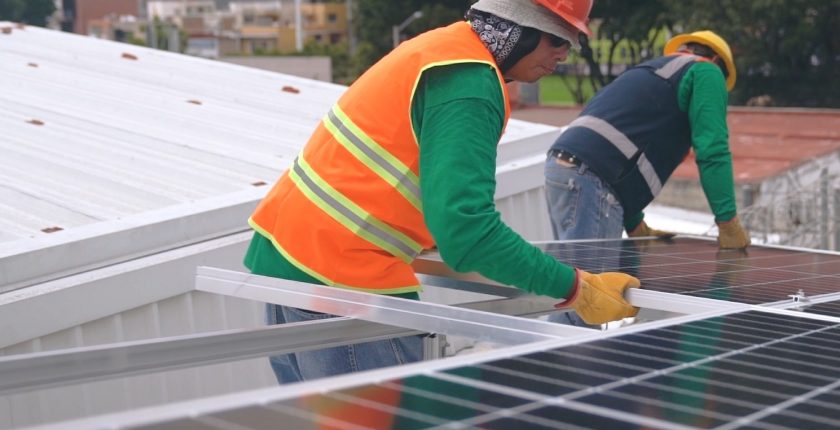How renewable energy is changing the construction industry
The world stands at a unique and hugely pivotal moment. As we finally begin to face up to the possibility of an environmental catastrophe, our focus has shifted dramatically towards renewable energy sources and how their use might help to reverse the effects of climate change.
But one key industry has, as of yet, remained sluggish in adopting new technologies and implementing renewable energy.
The world may be on the verge of great change, but the construction industry, and how it responds, will almost certainly play a vital role in how we tackle climate change and establish a more sustainable future.
The Construction Industry Today
The construction sector is a true juggernaut, with a CO2 output to match. It’s estimated that 11% of the world’s total CO2 emissions come from the construction sector, with a further 28% attributed to existing buildings’ operations.
It’s clear that to truly tackle the effects of climate change we will need to see substantial changes within the construction industry, but things are far from straightforward.
Even with the Covid-19 stoppages and uncertainty, the construction sector has rebounded impressively with an output of just over £122 billion in 2021. With orders now once again streaming in, demand has skyrocketed and many firms are as busy, or even busier than they were before the pandemic began.
With such a demand, it is often all too easy to fall back on the tried and tested ways of doing things, and the possible use of renewable energy or materials can quickly fall down the pecking order.
Making the Change
The construction sector is certainly not alone when it comes to its slightly lethargic approach to implementing renewable energy. Most industries face the same problem of having to place the long term benefits of addressing climate change above short term gain, but when it comes to construction, there are some exciting possibilities on the horizon.
Solar Energy
Solar power is often the most discussed form of renewable energy and it’s also the one that is seeing the greatest implementation within the construction sector.
While it’s becoming more common to see buildings that run exclusively on solar energy, we’re still not quite at the point of having solar-powered construction sites – but we are slowly creeping towards it.
Volvo seems to be at the forefront of this change, with a range of electric powered heavy machinery already on the market to replace the diesel guzzling beasts of old. Yet this is just the start, and at the ConExpo in 2021, Volvo demonstrated what could be the future of the construction industry – equipment that is powered wirelessly through solar energy.
Solar lanterns are quickly becoming a much cheaper and more efficient way of illuminating construction sites, while some new buildings come with photovoltaic windows installed, which are translucent panels that work to absorb the sun’s energy and transmute it into power. A simple change that can lead to an extraordinary 80% lower greenhouse gas emissions than fossil fuels.
Hydrogen Fuel Cells
Hydrogen is a relatively young upstart when it comes to renewable energy, but one that is already making huge waves. In 2020, part of the Viking Link Interconnector project, which is set to lay a 1,400 MW HVDC submarine power cable between the United Kingdom and Denmark, was among the first to use the new Siemens energy hydrogen fuel cell system to power its construction site.
This involved fuel cells being hosted in a large shipping container to which any device could be plugged in. Hyundai is attempting to go even better by developing hydrogen-fuelled excavators which should be on the market in 2023.
What does this mean for jobs in the construction sector?
Much of this new technology lurking just over the horizon won’t have any significant impact on jobs in the construction sector. The focus is heavily on the reduction of CO2 emissions through some of the means mentioned above and not on replacing humans.
As we move forward into the slightly blurry era that we shall call ‘the future’ there will almost certainly be a reduction in human need on construction sites, but this won’t necessarily be down to the integration of renewable energy.
With automation already well underway, we are already seeing robots and computers replace humans for certain jobs, but it will be a long time before large projects can be constructed without a vast team of humans behind them.
A Renewable Construction Industry
If the future is green, as is commonly said these days, the construction industry still has some way to go. But with a dazzling array of new technologies now in the offering, we could be on the cusp of some dramatic changes.
As with other industries, the construction sector will eventually need to make some hard decisions about long term benefits for the planet but there is more than enough there already to point towards a brighter future. As with everything when it comes to addressing the effects of climate change, it often comes down to the will of the people and their agreement to accept higher prices and perhaps even more inconveniences in the short term to ensure our planet’s long term survival.

